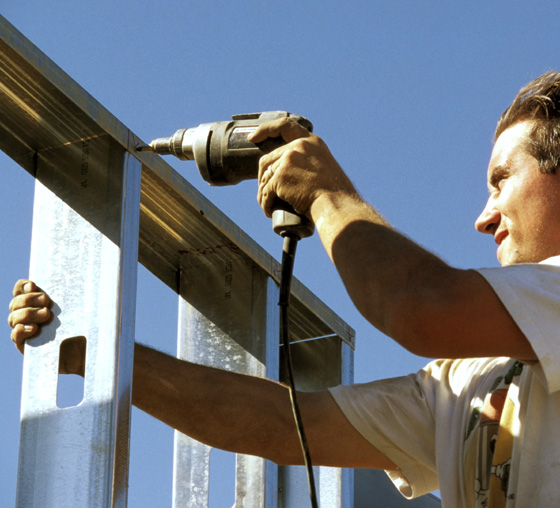Part 2: The Pros and Cons of Light Gauge Steel Framing
This second article in our three part series compares pre-engineered rigid-frame steel buildings to the advantages — and disadvantages of light gauge steel-framed buildings. (See Part 1 and Part 3.)
Light Gauge Metal Framing
Some builders continue to use the same basic framing techniques as traditional wood building, substituting light gauge steel studs for wood studs.
 There are certainly benefits when using light-gauge steel over wood. Light-gauge is more fire, mold, and termite resistant than wood. It is also eco-friendly, creates less waste, and far more durable. Light-gauge steel framing also earns discounts on insurance.
There are certainly benefits when using light-gauge steel over wood. Light-gauge is more fire, mold, and termite resistant than wood. It is also eco-friendly, creates less waste, and far more durable. Light-gauge steel framing also earns discounts on insurance.
However, light-gauge steel framing has definite drawbacks.
Labor Intensive
Framing with light-gauge steel is very time-consuming. In construction, time is money.
As with wood, all the work must be done in the field. Every stud must be cut to length with a special chop saw. Every one of the numerous connections requires several self-drilling screws.
Since light gauge steel framing imitates wood, it needs just as many framing pieces. More pieces mean a longer, more complicated construction time. More framing pieces also means more weight and stress on the foundation.
Stronger, commercial-grade rigid-framed steel uses far fewer framing pieces, so reduces the stress on the foundation—and it reduces the construction time, too.
Performance Problems
More pieces mean more connections along which outside temperatures slip inside. Thermal transference makes light-gauge structures more costly to heat and cool than prefabricated red-iron steel buildings like those from RHINO.
As with wood framing, light-gauge steel framing requires interior load-bearing walls. Clear-span interiors are problematic. Floor plan changes are difficult.
Some places experience a problem in light-gauge metal buildings known as “ghosting.” Interior walls start to discolor where studs are located, requiring frequent repainting.
Light-gauge steel framing is more consistent than wood, but still less dependable than rigid-frame pre-engineered steel buildings. Light-gauge steel still falls far short of being the best construction method.
RHINO-Tough Metal Buildings
Speed, ease of assembly, and problem-free operation make RHINO’s prefabricated steel buildings the better choice. And you will be surprised how truly affordable RHINO’s top-of-the-line metal buildings can be.
See for yourself why so many people choose RHINO for all their metal building needs. RHINO delivers anywhere in the U.S., Canada, or Mexico. Call now at 940.383.9566.
